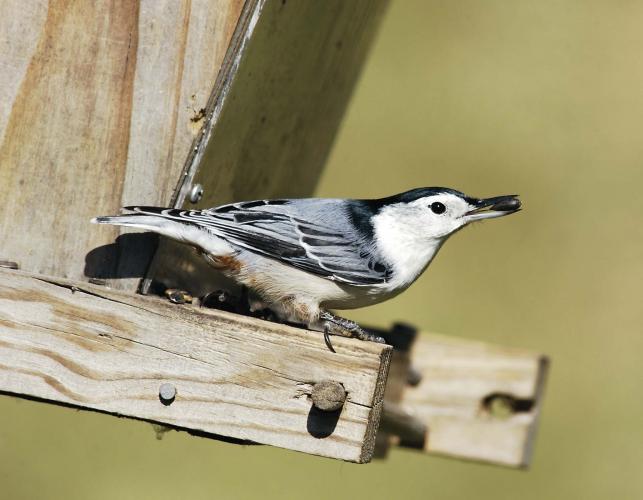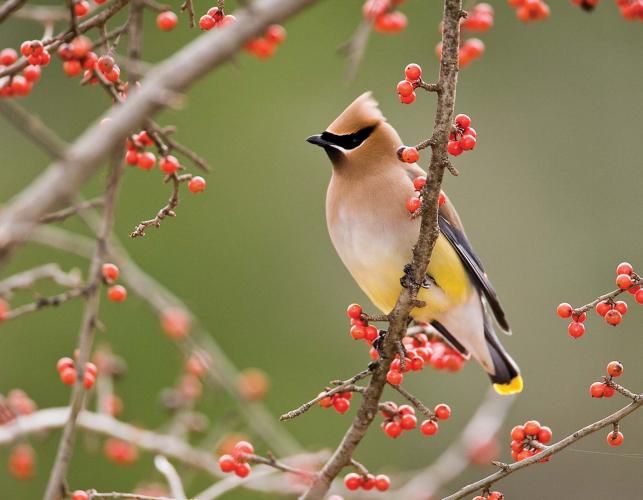Missouri is a great state for birds. Of the approximately 900 species in North America, more than 400 have been recorded in Missouri, and more than 150 species regularly nest in our state. Maintaining a birdfeeder in your yard is an entertaining and relatively easy way to get to know some of them.
Birds certainly benefit from easy access to food in feeders, but keep in mind that they would do just fine without it. The real beneficiaries of backyard bird feeding are people; birds at feeders are beautiful to watch, often amusing, and companionable. To keep birds returning to your feeders in any season, you need to provide them with three essential elements:
- A variety of good-quality seed
- Fresh water for drinking and bathing
- Plenty of places to take cover — preferably native trees and shrubs. Native plants also provide potential nesting sites and sources of natural food.
Two million Missourians enjoy observing, feeding, and photographing wildlife near their homes. Backyard birding is a fun and easy way to enjoy the outdoors all year.
What is the Best Season to Feed Birds?
While winter is the most popular time to stock feeders, many people enjoy feeding birds year-round. That’s because different species visit feeders during different seasons. For example, some birds are only summer residents in Missouri, others are here only in the winter months. Behavior also changes with the seasons. In the spring and summer, many young birds follow their parents to the feeder. It is fascinating to watch the adults show their young how to crack open seeds.
People often say that once you start feeding birds, it’s better for them if you remain diligent and continue to feed them routinely. In fact, no research indicates that during normal weather, birds will starve if feeding is stopped for a time. Remember, birds are highly mobile and resourceful. They often visit many feeding stations in a neighborhood, and if yours runs out, they will seek food elsewhere.
What Should My Feeding Station Look Like?
Your bird feeding station may be as simple or as elaborate as you like. You may choose to simply scatter seeds on the ground, build your own platform, or hang several store-bought feeders of various shapes and sizes throughout your yard. Remember that there are differences in feeding habits among birds. Songbirds, such as the dark-eyed junco or white-crowned sparrow, prefer to feed directly on the ground. Cardinals and blue jays will feed either on the ground or on a platform. Goldfinch and chickadees also will visit small, plastic feeders that are fixed to the outside of a window by a suction cup. Because feeding birds is primarily for your own pleasure, place your feeders where you can see them from a favorite, inside vantage point.
What Are the Best Types of Foods?
A report by the U.S. Fish and Wildlife Service — based on almost 750,000 observations of birds choosing between two or more seed types at specially constructed feeding stations — shows that those species that prefer large seeds are highly attracted to sunflower seed. The most favored is the smaller, black-oil sunflower seed and not the more familiar striped varieties. The study included several seed types, but three
Common Winter Birds
Here a just a few of the birds you might spot at your feeders this winter.
Downy Woodpecker
The tiny, black-and-white backed woodpecker. Common year-round in forests and wooded neighborhoods. Especially attracted to suet feeders and sunflowers. Males have small red patches on the backs of their heads.
Eastern Bluebird
Missouri’s state bird. The bright blue bird with a reddish chest is seen year-round, but is less common in winter. Find them in grasslands with scattered trees, open areas, and backyards in rural areas. They will often nest in boxes mounted on fence posts.
White-breasted Nuthatch
The upside-down bird. Common year-round in woodlands, parks, and suburban areas. Forages for insects, seeds, and berries. Often walks upside down on tree trunks and branches.
Dark-eyed Junco
The busy “snowbird” on the ground under your feeder. Common in shrubs and brushy areas in winter; spends the summer in Canada and northern United States. They flock to feeders in groups and are sometimes the most frequent feeder visitors.
Northern Mockingbird
The birdsong impersonator. Common year-round in shrubs and brushy areas. Song is varied and mimics other birds. Often seen walking along the ground opening and closing its wings.
American Goldfinch
In summer, the canary-yellow bird with black wings. Found year-round in grasslands and suburban areas. They stick together in flocks and have a noticeable undulating — or dipping — flight pattern. Their yellow color fades to olive in winter.
Black-capped Chickadee / Carolina Chickadee
The common feeder birds that call chickadee-dee-dee. Common year-round in forests, woodlands, and neighborhoods with plenty of large trees. The black-capped is found in northern Missouri and the Carolina in southern Missouri. Similar in appearance, the black-capped has more white on its wing in winter and its call is slower. Both are frequent visitors to feeders and easily approached.
Tufted Titmouse
The scolding bird with a pointed crest atop its head. Lives year-round in forests, woodlands, and suburban areas. Makes a distinct peter-peter-peter whistling sound.
Northern Cardinal
A common permanent resident. It forages on the ground or in shrubs for insects, spiders, seeds, fruits, and berries. The “redbird” is a frequent visitor to bird feeders for sunflower and other seeds. Females are buffy tan below and grayish brown above, otherwise similar to male. By February, cardinals are in full song, singing from the tops of small trees and shrubs most of the day.
Song Sparrow
Missouri’s permanent-resident sparrow. Common year-round in weedy fields, brushy floodplains, and at bird feeders in most of Missouri, except rare in the Ozarks. Missouri has 19 different species of sparrow, and they are one of the more difficult groups of birds to identify.
Mourning Dove
The cooing lovebird. Found in grasslands, towns, and suburbs. Common year-round, though especially abundant in spring and summer, less so in fall, and rare in winter. Shaped somewhat like rock pigeons, though slimmer.
Blue Jay
Though this common permanent resident may be present all year in your yard, they are probably different individuals during each season. They frequently chase smaller birds away from bird feeders, gather up several seeds, and then fly off to cache them in a tree or in the ground. Blue jays are frequently noisy and easily detected in tree canopies. They often form groups and chase and mob hawks and owls they encounter.
stand out as being the best foods for attracting the most species of birds:
- Black-oil sunflower seeds attract the widest variety of birds that eat seeds. It can be purchased at reasonable prices in bulk, usually 25- to 50-pound bags. It’s best to avoid buying small bags of colorful, mixed seeds. They often contain common cereal grains such as milo, wheat, oats, and rice that few birds will eat.
- White millet, also available in bulk, is appealing to doves, sparrows, juncos, and other birds that feed on the ground. It works well to scatter it on the ground underneath a feeder that is stocked with black-oil sunflower seed. Cracked corn is also inexpensive and recommended for spreading around on the ground for doves and sparrows. Squirrels eat corn, too, and it may help somewhat in keeping them out of your feeders.
- Niger “thistle” is a small seed that usually goes into cylindrical feeders equipped with several perches and small holes from which the birds extract seeds. American goldfinches and purple finches, especially, are attracted to niger. It is more expensive than black-oil sunflower seeds, but fewer species eat it; consequently, it lasts somewhat longer.
In addition to seeds, birds also eat suet, fruit, and nectar. Suet, which is made from animal fat, is sold in small blocks and fits into specially designed wire cages that can hang from a limb or post. In summer, suet will sometimes spoil in the heat if it goes uneaten for a long period of time. If this happens, throw it out and start over with a fresh block, and try to hang it in a shady spot. Peanut butter is a good substitute for suet in the summer. Mix one part peanut butter with five parts corn meal and stuff the mixture into holes drilled in a hanging log or into the crevices of a large pinecone. This all-season mixture — as well as suet — attracts woodpeckers, chickadees, titmice, and, occasionally, warblers.
Some birds such as waxwings, bluebirds, and mockingbirds eat fruit and rarely birdseed. To attract these birds, soak raisins and currants in water overnight, and then place them on a table feeder. To attract orioles and tanagers, cut oranges in half and skewer them onto a spike and place them near other feeders.
Ruby-throated hummingbirds are attracted to nectar feeders. Hummingbird feeders are fairly inexpensive, and it is easy to make the sugar-water “nectar” yourself. Simply make a sugar solution of one part white sugar to four parts water. There is no need to add red food coloring. Feeders must be washed every few days with very hot water and kept scrupulously clean to prevent the growth of bacteria. Change the nectar at least weekly, or more often if it becomes cloudy.
Never use artificial sweeteners in feeders. Honey-water is sometimes wrongly recommended because it has a higher nutrient content than sugar-water. There are great dangers in using honey, however, because if the solution is not boiled and the feeder not cleaned each time before filling, a fungus that will attack the bird’s tongue can grow in the mix. In Missouri, hummingbirds typically visit feeders April 25 to the end of September, with the spring and fall seasons being the busiest.
What About Water and Landscaping?
To increase the popularity of your feeding station, furnish water — preferably year-round. The Carolina wren and the bluebird, Missouri’s state bird, may be enticed to feeding stations during the winter if water is available. During prolonged periods of ice or snow cover, provide grit (coarse sand or ground shells) along with the seed. Birds lack teeth, and the grit that they keep in their gizzards is used to grind up seeds.
Besides furnishing the most attractive seed and a clean water supply, you may entice birds to your yard in other ways. Native trees, shrubs, vines, and flowers not only produce food for birds, they also provide cover. Many decorative trees and shrubs produce fruits and berries for birds. Holly, hawthorn, and persimmon, for example, are favorites of cedar waxwings.
In new housing developments, trees and shrubs that birds use for nesting, perching, and escaping predators are often in short supply. Birds need places to perch overnight and vantage points from which they not only can approach your feeder, but from where they also can watch for potential predators.








Also In This Issue


And More...
This Issue's Staff
Managing Editor - Nichole LeClair Terrill
Art Director - Cliff White
Staff Writer - Jim Low
Photographer - Noppadol Paothong
Photographer - David Stonner
Designer - Stephanie Thurber
Artist - Mark Raithel
Circulation - Laura Scheuler






















